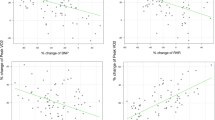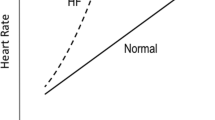Abstract
Aims
This prospective pilot-study was performed to assess whether regular moderate physical activity elevates the parasympathetic tone to the atrio-ventricular node and decreases VR during permanent AF.
Background
Adequate ventricular rate (VR) control in patients with permanent atrial fibrillation (AF) is not easy to accomplish.
Methods
10 patients (mean age 59 ± 10 years) with permanent AF (duration: 10 ± 8 years) underwent moderate physical exercise adjusted to their individual physical capability (45 min walking/jogging twice a week). To analyze VR control physical exercise tests and Holter-ECG recordings were performed before and after 4 months. In addition, stepwise lactate tests and psycho-pathometric examinations were obtained.
Results
After 4 months of training, there was a trend toward a decrease of mean VR in 24 h Holter-ECGs by 12% from 76 ± 20 to 67 ± 12 bpm (P = 0.05) while there was no significant decrease of the minimal VR (38 ± 8 vs. 36.3 ± 4.5 bpm, P = 0.54). At a lactate threshold of 2 mmol/l there was a trend towards an increase of the running speed from 105 ± 11 to 116 ± 12 m/min (P = 0.05). A significant VR decrease of 8% (range 5–10%) was observed at almost all exercise levels during exercise treadmill testing. Increases of exercise capacity and decreases of VR were accompanied by subjective improvements of health perception.
Conclusion
Regular moderate physical activity decreases VR at rest and during exercise while increasing exercise capacity. Physical training should be taken into account for ventricular rate control during AF.



Similar content being viewed by others
Abbreviations
- AF:
-
Atrial fibrillation
- VR:
-
Ventricular rate
- QOL:
-
Quality of life
References
Borg G (1970) Perceived exertion as an indicator of somatic stress. Scand J Rehab Med 2:92–98
Chung MK, Shemanski L, Sherman DG, Greene HL, Hogan DB, Kellen JC, Kim SG, Martin LW, Rosenberg Y, Wyse DG (2005) AFFIRM investigators. Functional status in rate-versus rhythm-control strategies for atrial fibrillation: results of the atrial fibrillation follow-up investigation of rhythm management (AFFIRM) functional status substudy. J Am Coll Cardiol 46:1891–1899
Danson EJ, Mankia KS, Golding S, Dawson T, Everatt L, Cai S, Channon KM, Paterson DJ (2004) Impaired regulation of neuronal nitric oxide synthase and heart rate during exercise in mice lacking one nNOS allele. J Physiol 558(3):963–974
Danson EJF, Paterson DJ (2003) Enhanced neuronal nitric oxide synthase expression is central to cardiac vagal phenotype in exercise-trained mice. J Physiol 546:225–232
Hagens VE, Vermeulen KM, TenVergert EM, Van Veldhuisen DJ, Bosker HA, Kamp O, Kingma JH, Tijssen JG, Crijns HJ, Van Gelder IC (2004) RACE study group. Rate control is more cost-effective than rhythm control for patients with persistent atrial fibrillation–results from the rate control versus electrical cardioversion (RACE) study. Eur Heart J 25:1542–1549
Hamilton M (1960) A rating score for depression. J Neurol Neurosurg Psychatry 23:56–62
Hegbom F, Sire S, Heldal M, Orning OM, Stavem K, Gjesdal K (2006) Short-term exercise training in patients with chronic atrial fibrillation: effects on exercise capacity, AV conduction, and quality of life. J Cardiopulm Rehabil 26:24–29
Howes CJ, Reid MC, Brandt C, Ruo B, Yerkey MW, Prasad B, Lin C, Peduzzi P, Ezekowitz MD (2001) Exercise tolerance and quality of life in elderly patients with chronic atrial fibrillation. J Cardiovasc Pharmacol Ther 6:23–29
Kannel WB, Abbot RD, Savage DD, McNamara (1982) Epidemiological features of atrial fibrillation. The Framingham study. N Engl J Med 306:1018–1022
Karapolat H, Eyigor S, Zoghi M, Yagdi T, Nalbantgil S, Durmaz B, Ozbaran M (2008) Effects of cardiac rehabilitation program on exercise capacity and chronotropic variables in patients with orthotopic heart transplant. Clin Res Cardiol March 3. [Epub ahead of print]
Miche E, Roelleke E, Wirtz U, Zoller B, Tietz M, Huerst M, Radzewitz A (2008) Combined endurance and muscle strength training in female and male patients with chronic heart failure. Clin Res Cardiol April 23. [Epub ahead of print]
Opolski G, Torbicki A, Kosior DA, Szulc M, Wozakowska-Kaplon B, Kolodziej P, Achremczyk P (2004) Investigators of the polish how to treat chronic atrial fibrillation study. Rate control vs. rhythm control in patients with nonvalvular persistent atrial fibrillation: the results of the polish how to treat chronic atrial fibrillation (HOT CAFE) study. Chest 126:476–486
Singh BN, Singh SN, Reda DJ, Tang XC, Lopez B, Harris CL, Fletcher RD, Sharma SC, Atwood JE, Jacobson AK, Lewis HD Jr, Raisch DW, Ezekowitz MD (2005) Sotalol amiodarone atrial fibrillation efficacy trial (SAFE-T) investigators. Amiodarone versus sotalol for atrial fibrillation. N Engl J Med 352:1861–1872
Thrall G, Lane D, Carroll D, Lip GY (2006) Quality of life in patients with atrial fibrillation: a systematic review. Am J Med 119:448:e1–e19
van den Berg MP, Hassink RJ, Tuinenburg AE, van Sonderen EF, Lefrandt JD, de Kam PJ, van Gelder IC, Smit AJ, Sanderman R, Crijns HJ (2001) Quality of life in patients with paroxysmal atrial fibrillation and its predictors: importance of the autonomic nervous system. Eur Heart J 22:247–253
Van Gelder IC, Hagens VE, Bosker HA, Kingma JH, Kamp O, Kingma T, Said SA, Darmanata JI, Timmermans AJ, Tijssen JG, Crijns HJ (2002) Rate control versus electrical cardioversion for persistent atrial fibrillation study group. A comparison of rate control and rhythm control in patients with recurrent persistent atrial fibrillation. N Engl J Med 347:1834–1840
Vanhees L, Schepers D, Defoor J, Brusselle S, Tchursh N, Fagard R (2000) Exercise performance and training in cardiac patients with atrial fibrillation. J Cardiopulm Rehabil 20:346–352
Ware JE Jr, Sherbourne CD (1992) The MOS 36-item short-form health survey (SF-36). Conceptual framework and item selection. Med Care 30:473–483
Wyse DG, Waldo AL, DiMarco JP, Domanski MJ, Rosenberg Y, Schron EB, Kellen JC, Greene HL, Mickel MC, Dalquist JE, Corley SD (2002) Atrial fibrillation follow-up investigation of rhythm management (AFFIRM) investigators. A comparison of rate control and rhythm control in patients with atrial fibrillation. N Engl J Med 347:1825–1833
Yamamoto K, Miyachi M, Saitoh T, Yoshioka A, Onodera S (2001) Effects of endurance training on resting and post-exercise cardiac autonomic control. Med Sci Sports Exerc 33:1496–1502
Acknowledgment
There is no conflict of interest of any of the authors.
Author information
Authors and Affiliations
Corresponding author
Additional information
The study was supported by the German Atrial Fibrillation Competence Network (AFCN) funded by the Fedral Ministry of Education and Research (FMBI).
A. Blumberg and J. Plisiene contributed equally to this study.
Rights and permissions
About this article
Cite this article
Plisiene, J., Blumberg, A., Haager, G. et al. Moderate physical exercise: a simplified approach for ventricular rate control in older patients with atrial fibrillation. Clin Res Cardiol 97, 820–826 (2008). https://doi.org/10.1007/s00392-008-0692-3
Received:
Accepted:
Published:
Issue Date:
DOI: https://doi.org/10.1007/s00392-008-0692-3




